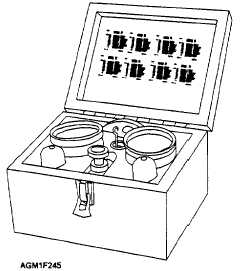Balloon Inflation
Balloons should be inflated slowly, with helium. A
10-gram balloon should take 3/4 to 1 minute to fill, and a
30-gram balloon should take 2 l/2 to 3 minutes to fill.
This slow inflation rate allows the balloons to stretch
properly during filling.
The balloons are inflated by using the ML-575/UM
universal balloon balance set (fig. 2-45). Refer to the
technical data supplied with the set for detailed
information. The 10-gram balloons, attached to the
inflation nozzle weighted to 45 grams, are inflated to
neutral buoyancy. This yields 45-grams of free lift. The
30-gram balloons are inflated to 139-gram free lift.
Chemical lights and balloon-tying cords are added to
the inflation nozzle during inflation, but are not
calculated in the weighting figures.
Determination of Cloud Height
You must always request permission from the
Officer of the Deck (OOD) and the Air Boss aboard a
carrier, or from the air traffic controller at an air station,
to release a ceiling balloon. After clearance is received,
the ceiling balloon is released and the ascension is
timed. Cloud height is determined by the elapsed time,
in minutes and seconds, that the balloon takes to enter
into the cloud base. Consider the point of entry as
midway between the time the balloon first begins to
fade and the time of complete disappearance for layers
aloft. Use the point at which the balloon disappears to
estimate vertical visibility. Use the standard ascension
rate tables in either NAVMETOCCOMINST 3141.2 or
NAVMETOCCOMINST 3144.1 to determine the
height.
So far, we have covered most of the equipment used
in surface aviation weather observations. We have
mentioned a few of the calculators used to compute
Figure 2-45.—ML-575/UM universal balloon balance set.
observational data, such as the psychrometric computer
and the true wind computer. Now let’s discuss the
various types of calculators used
observations.
Q41.
Q42.
Q43.
Q44.
Q45.
Q46.
Q47.
Q48.
Q49.
Q50.
REVIEW QUESTIONS
What are the three main parts
507/GMQ-13 Cloud Height Set?
in surface
of the ML-
When you use the ML-507/GMQ-13, how are
cloud heights determined?
What data must be computedfor each individual
RO-546/GMQ-13 GIFFT recorder?
When is the correction factor of the GIFFT
recorder not applied?
What instrument is used in conjunction with the
ML-121 Ceiling Light Projector to obtain cloud
heights?
What publication contains instructions for using
the shipboard clinometer?
How are cloud heights determined when using a
clinometer?
Under what conditions should red ceiling
balloons be used to measure cloud heights?
Why should larger, 30-gram balloons be used in
high wind conditions vice 10-gram balloons?
How is cloud height determined when you use
ceiling balloons?
CALCULATORS
LEARNING OBJECTIVE: Explain the care
and use of four types of hand-held calculators.
In the 1930’s and 1940’s, the military first made
serious attempts to study the weather and apply it
operationally. Much of the data, such as dew-point
temperature and relative humidity, had to be determined
from printed tables (such as those available in the
Smithsonian Meteorological Tables) or calculated
manually. In the ensuing decades, as meteorology
became more of a precise science, many paper
nomograms and metal or plastic calculators were
developed to make the calculations easier. These
nomograms and calculators helped free the user from
bulky printed tables. Although the built-in
computational power of the ASOS and SMOOS
perform many of these calculations, we include this
section on the proper use and care of the most frequently
2-35



